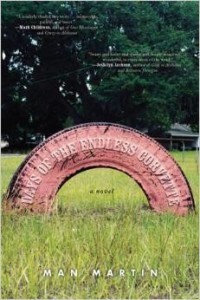Frogs, Hot Water, and the Seven Deadly Sins: Making Trouble for Characters
by Man Mart
in,
@manmartin1

I’ve been reading students’ unpublished novels for a summer class I’m teaching alongside Nancy Zafris at Kenyon College in Ohio. Again and again, I see the same fundamental flaw: the characters refuse to get into trouble. This is understandable. Most of us – except for the hopelessly neurotic – are very good at avoiding trouble. This isn’t to say we run from challenges, but trouble itself we stay out of. If there are difficult people with whom we can’t get along, we either stay out of their way entirely or deal with them on a superficial level, being as outwardly courteous as we can stand. We do not take deliberate actions to sabotage our love lives or our careers. For the most part, we obey the law. We don’t embezzle funds or commit murder.
No one should get into trouble if there’s any way to avoid it. Trouble makes everyone unhappy. Trouble prevents us from self-fulfillment. Trouble causes stress and migraines. Trouble is just too much trouble.
The trouble is, trouble is precisely what your characters have to get into. Ahab can’t say, “Whew! That durn whale chawed off my leg! I’m staying on shore from here on!” Romeo can’t say, “Juliet’s the daughter of my enemy? Uh-oh, better steer clear of her!” Humbert Humbert can’t say… Well, ahem, you get the idea.
I remember as a child, when someone in a book or tv show pulled some especially bone-headed maneuver, asking my mother, “Why did So-and-So do that?” What I was really asking was, why would anyone do something that was only guaranteed to get them deeper into trouble? My mother’s wise response was, “Well, if they didn’t do that, we wouldn’t have a story.”
That’s the key to the whole thing. Characters can’t just be in trouble – they have to get into it by their own wilful actions. No trouble, no story. That’s the genius of Huck Finn; Jim is escaping slavery on the Mississippi which heads south; the longer they’re on the river, the deeper into trouble they go.
The story of our lives is largely one of how we stayed out of trouble, or managed to get out of trouble with a minimum of pain once we got into it. In fiction, it’s just the opposite: it’s characters getting into trouble in the first place, and making it as bad as possible for themselves before they get out, if they ever do. So how does a writer, who like any healthy human being, is a gifted trouble-avoider, create a character who gets into trouble?
When it comes to getting characters in trouble, writers have an external knob they can twist and an internal one. The external knob is the outside circumstances. If a character is marooned in a lifeboat with nothing but another shipmate and a book called, 101 Tasty Recipes for Shipmate, you know he’s going to get into trouble and you have a pretty clear idea of what kind of trouble. The internal Knob is your character’s propensities. The Seven Deadly Sins are a virtual how-to list for making people get into trouble. Envy, Greed, Wrath, and Lust are perennial favorites, and, of course, Pride was the go-to among the Ancient Greeks. For some reason, not many writers use Gluttony or Sloth, but even those have been done.
There’s a saying that if you put a frog in a pot of water and turn the heat up slowly, the frog will boil to death, never realizing the temperature is changing. As a writer, you don’t want to do it that way. Get the water as hot as you can as quickly as you can, and stoke your frog with sufficient Wrath, Pride, Envy or whatever to make him jump.
And that’s where your story begins.
Man Martin is two-time winner of Georgia Author of the Year for Days of the Endless Corvette, and Paradise Dogs. He blogs daily at manmartin.blogspot.com
The post Frogs, Hot Water, and the Seven Deadly Sins: Making Trouble for Characters appeared first on Elizabeth Spann Craig.




